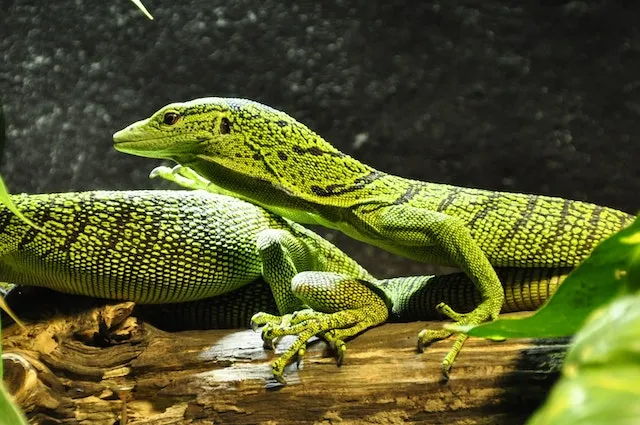Why Are There So Many Lizards In Florida?
With over 50 native lizard species slithering around, Florida is known for its abundant and diverse lizard population. If you’ve ever visited the Sunshine State, you’ve probably noticed tiny anole lizards scurrying around everywhere. So what makes Florida such a lizard haven? If you’re short on time, here’s a quick answer to your question: Florida’s subtropical climate, habitat diversity, and lack of freezing winters allow many lizard species to thrive. Read on to learn more about the ecological and geographical factors that make Florida a lizard lover’s paradise.
Ideal Climate
One of the main reasons why there are so many lizards in Florida is because of its ideal climate. The state’s warm weather year-round provides the perfect habitat for lizards to thrive. With temperatures rarely dropping below freezing, lizards are able to remain active and reproduce throughout the entire year.
Warm Weather Year-Round
Florida’s warm weather creates a comfortable environment for lizards. Unlike many other regions with colder climates, lizards in Florida don’t have to hibernate or go into a state of dormancy during the winter months.
This allows them to continue foraging for food and mating, leading to a higher population density.
Lizards are ectothermic, which means they rely on external sources of heat to regulate their body temperature. The warm and sunny climate in Florida provides an abundance of heat for lizards to bask in, allowing them to maintain optimal body temperature for growth and activity.
Ample Rainfall and Humidity
Another factor that contributes to the abundance of lizards in Florida is the state’s ample rainfall and humidity. Lizards, like other reptiles, require a certain level of humidity to thrive. The high humidity in Florida creates a favorable environment for lizards, as it helps to keep their skin moist and aids in the shedding process.
The frequent rainfall in Florida also ensures a constant supply of water for lizards to drink. This availability of water sources is vital for their survival and reproductive success. Additionally, the abundant vegetation that thrives in Florida’s humid climate provides lizards with ample food sources and hiding places.
According to a study conducted by the University of Florida, the state’s warm and humid climate is particularly attractive to non-native lizard species, which have thrived and established populations in the region.
These non-native species, such as the brown anole and the green iguana, have proliferated in Florida’s ideal climate, further contributing to the overall lizard population.
Diverse Habitats
Florida is known for its diverse habitats, which provide the ideal conditions for lizards to thrive. From coastal strands to freshwater wetlands, the state offers a wide range of environments for these reptiles to inhabit.
Coastal Strand
Coastal strands are sandy areas found along the coastline of Florida. These habitats are characterized by dunes, salt-tolerant plants, and a mix of open and shaded areas. Lizards such as the Green Anole (Anolis carolinensis) and the Mediterranean Gecko (Hemidactylus turcicus) are commonly found in these coastal strands.
The sandy soil provides an excellent substrate for these lizards to burrow and hide.
Scrub
The scrub habitats of Florida are unique and characterized by sandy, well-drained soil and the presence of low-growing shrubs. These areas are home to a variety of lizards, including the Florida Scrub Lizard (Sceloporus woodi) and the Eastern Fence Lizard (Sceloporus undulatus).
The dense vegetation in the scrub provides ample hiding places for these lizards, allowing them to blend into their surroundings.
Pine Flatwoods
The pine flatwoods are dominated by pine trees and have a sandy soil with a thick layer of pine needles. These habitats are home to several species of lizards, including the Six-lined Racerunner (Aspidoscelis sexlineatus) and the Southeastern Five-lined Skink (Plestiodon inexpectatus).
These lizards can often be seen basking on fallen logs or darting through the underbrush.
Freshwater Wetlands
Florida’s freshwater wetlands, such as marshes and swamps, provide a unique habitat for lizards. These areas are characterized by standing water and a variety of aquatic vegetation. The Green Anole (Anolis carolinensis) and the Brown Anole (Anolis sagrei) are commonly found in these wetland habitats.
These lizards are excellent swimmers and are well-adapted to the watery environment.
Lack of Freezing Temperatures
One of the main reasons why there are so many lizards in Florida is the lack of freezing temperatures. Unlike other parts of the United States, Florida has a subtropical climate, which means that temperatures rarely drop below freezing.
This allows lizards, particularly those from tropical regions, to thrive and expand their ranges in the state.
Allows Tropical Lizards to Expand Ranges
The absence of freezing temperatures in Florida provides the perfect habitat for tropical lizards to expand their ranges. Many species of lizards that are native to the Caribbean and other tropical areas have found a new home in Florida.
These lizards, such as the green anole and the brown anole, have been able to establish populations throughout the state due to the favorable climate.
According to a study conducted by the University of Florida, the warm temperatures in the state have allowed the green anole to expand its range by over 50% in the past few decades. This is a significant increase and demonstrates the impact that the lack of freezing temperatures has on lizard populations.
Reduces Lizards’ Winter Mortality
Another important factor is that the lack of freezing temperatures reduces the winter mortality rate of lizards in Florida. In colder regions, lizards often hibernate or become dormant during the winter months to survive the harsh conditions.
However, in Florida, lizards can remain active and continue to forage for food throughout the year.
This extended period of activity allows lizards to maintain their energy levels and avoid starvation during the winter months. As a result, the survival rate of lizards in Florida is higher compared to regions with freezing temperatures.
This contributes to the overall abundance of lizards in the state.
Abundant Food Supply
One of the main reasons why there are so many lizards in Florida is the abundant food supply available to them. The warm and humid climate of Florida provides the perfect conditions for a wide variety of insects, small invertebrates, and fruits that lizards feed on.
Insects
Florida is home to a diverse range of insect species, including mosquitoes, flies, ants, and beetles. These insects serve as a primary food source for many lizard species. Lizards have a voracious appetite for insects and can consume a large number of them in a single day.
This abundance of insects ensures that lizards in Florida have a constant supply of food to sustain themselves.
Small Invertebrates
In addition to insects, Florida also has a significant population of small invertebrates such as spiders, centipedes, and worms. These creatures are a nutritious food source for lizards and contribute to their high population density.
Lizards have specialized adaptations such as long tongues and sharp teeth that allow them to efficiently capture and consume these small invertebrates.
Fruit
While insects and small invertebrates form the bulk of a lizard’s diet, some lizard species in Florida also consume fruits. The state is known for its abundance of fruit-bearing trees and plants, including citrus fruits, berries, and figs.
Lizards are opportunistic feeders and will readily consume ripe fruits that are easily accessible to them. This additional food source contributes to the overall abundance of lizards in Florida.
Prolific Reproduction
One of the main reasons why there are so many lizards in Florida is their ability to reproduce at a rapid rate. Lizards have developed several adaptations that allow them to have a high reproductive output, ensuring the survival of their species in the subtropical climate of Florida.
Rapid Maturation
Lizards in Florida are known for their quick maturation process. Unlike other reptiles, lizards reach sexual maturity at a relatively young age. This means that they can start reproducing earlier, leading to a higher number of offspring over their lifetime.
Some species of lizards in Florida can reach sexual maturity as early as six months old. This rapid maturation allows them to produce multiple generations in a short period of time.
Frequent Egg Laying
Another reason for the abundance of lizards in Florida is their ability to lay eggs frequently. Female lizards can lay multiple clutches of eggs each year, ensuring a continuous supply of new hatchlings.
Some species can lay up to four clutches per year, with each clutch containing anywhere from 5 to 15 eggs. This frequent egg laying increases the chances of successful reproduction and contributes to the high population of lizards in the state.
High Offspring Survivorship
Not only do lizards in Florida reproduce quickly and frequently, but they also have a high offspring survivorship rate. This means that a significant number of the hatchlings are able to survive and reach adulthood.
Lizards have adapted to the local environment and developed various strategies to protect their offspring from predators and harsh conditions. For example, some lizard species lay their eggs in hidden or underground locations to provide protection.
Additionally, lizards have the ability to regrow lost tails, which can distract predators and increase the chances of survival for the young lizards.
Conclusion
With its subtropical climate, diverse ecosystems, lack of freezing winters, plentiful food sources, and ideal breeding conditions, Florida offers a paradise for lizards to thrive. The state’s 50+ native species fill niches in habitats from the steamy Everglades to sunny coastal dunes. So next time you visit Florida and spot a skink scurrying by or an anole perched on a tree, know that you’re experiencing just a small part of the state’s prolific lizard life.








